Abstract
Twenty Staphylococcus aureus strains from patients with toxic shock syndrome (TSS) and 20 from control patients (non-TSS) with infection but no clinical evidence of TSS were compared phenotypically in a collaborative, blinded, randomized study. TSS strains were significantly (P less than 0.05) more likely than non-TSS strains to produce various previously described but related toxic shock-associated proteins (pyrogenic exotoxin C, enterotoxin F, and TSS marker protein), as well as differing in other distinctive phenotypic characteristics, such as hemolysis, bacteriocin susceptibility, arsenate resistance, pigment production, and casein proteolysis. TSS strains were significantly less likely to carry plasmids than control strains. A combination of two variables--proteolysis and toxic shock-associated protein production--statistically accounted for all other phenotypic variations between TSS and non-TSS strains. Only proteolysis covaried with all other significant variables, suggesting a primary role in the phenotypic distinctiveness of TSS S. aureus strains and possibly in the pathogenesis of TSS.
Full text
PDF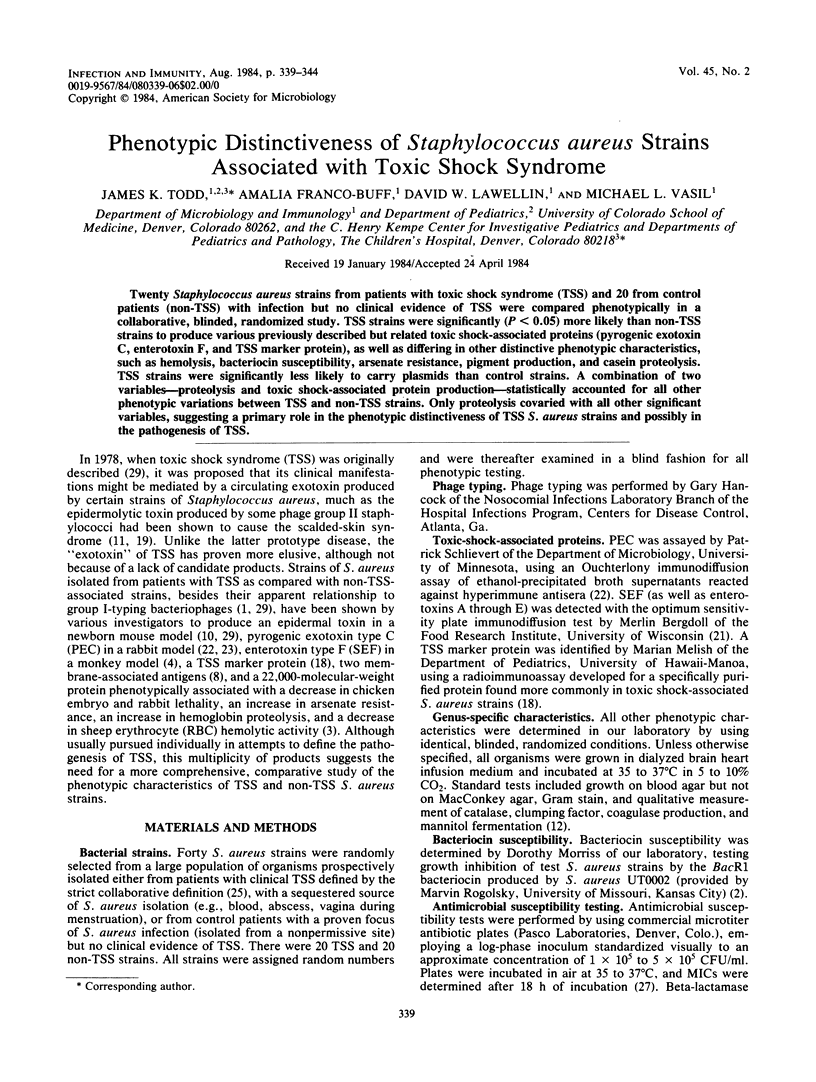
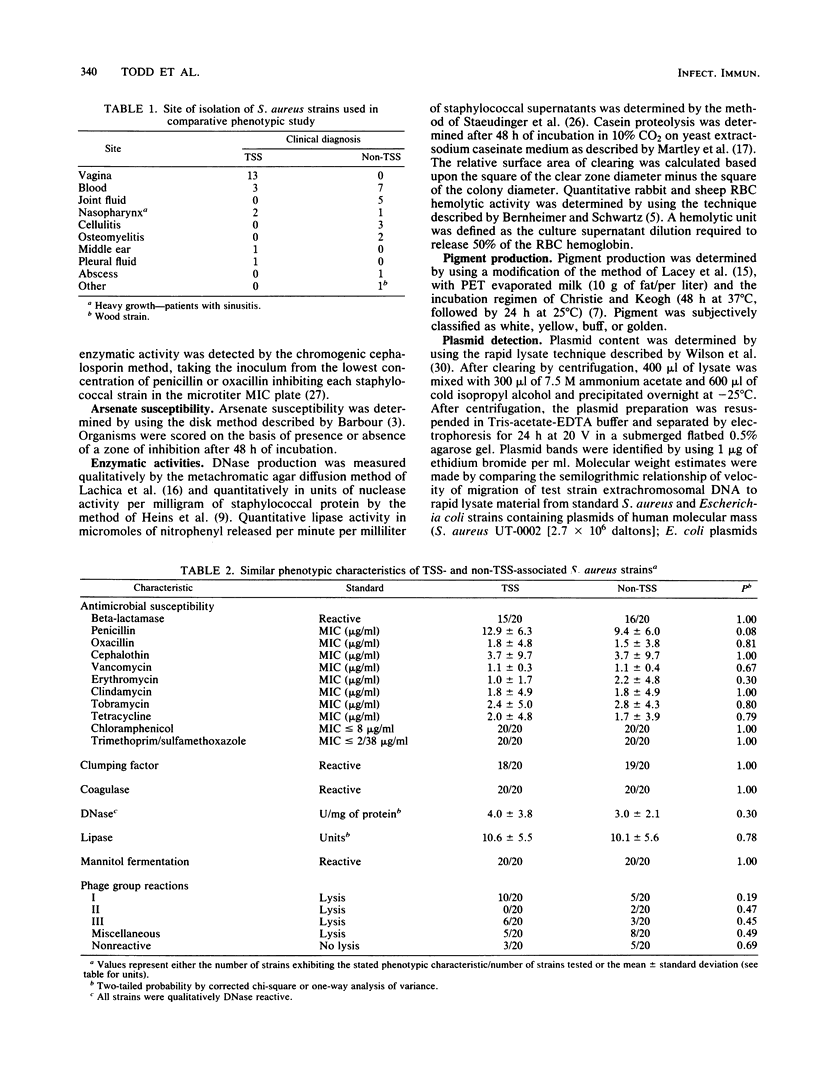
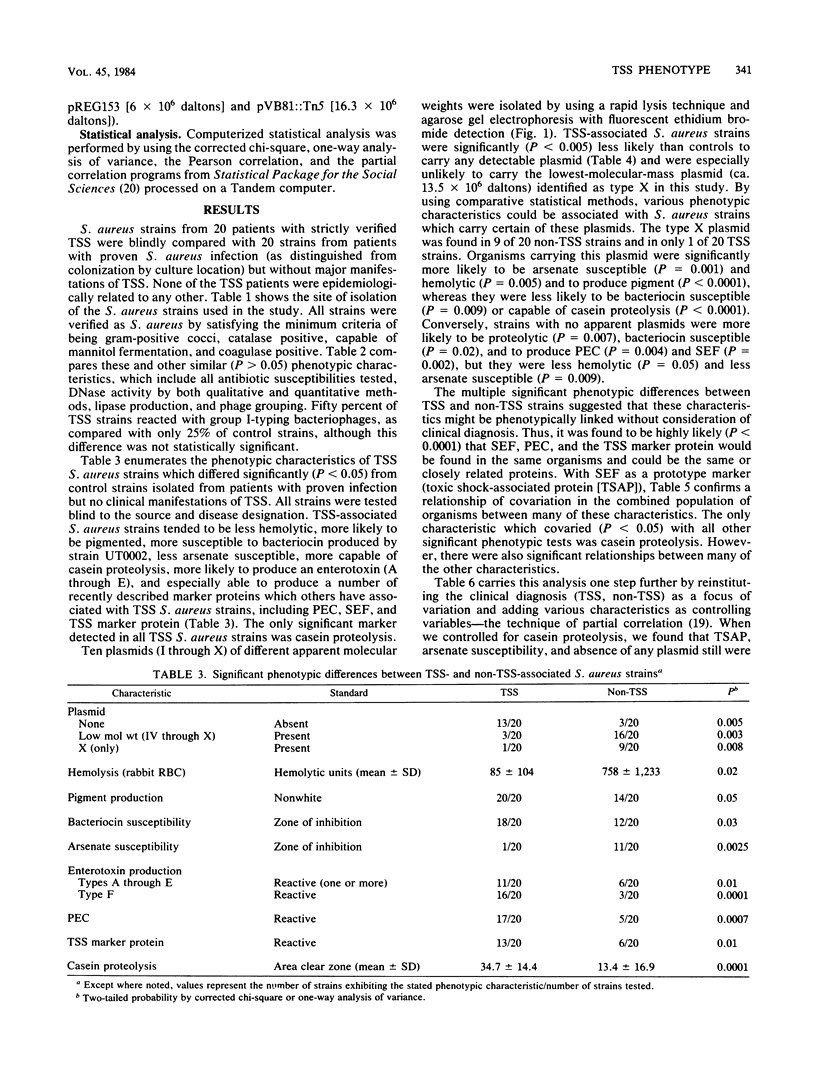
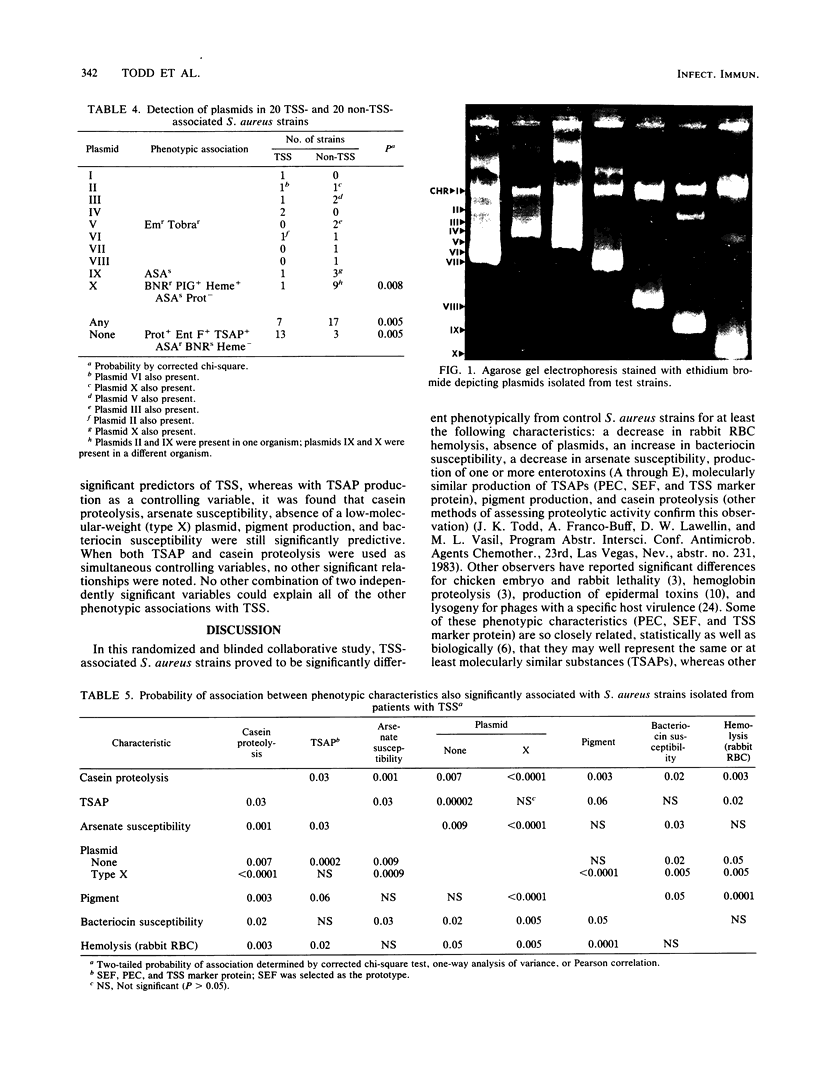
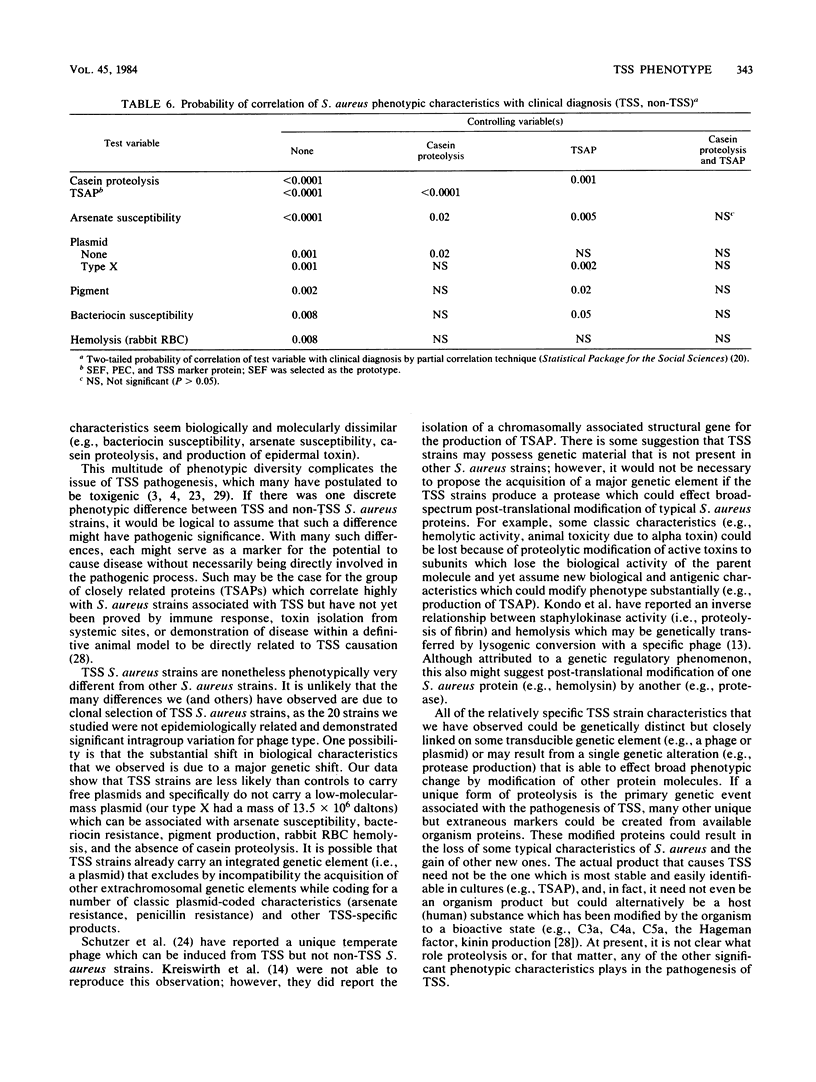
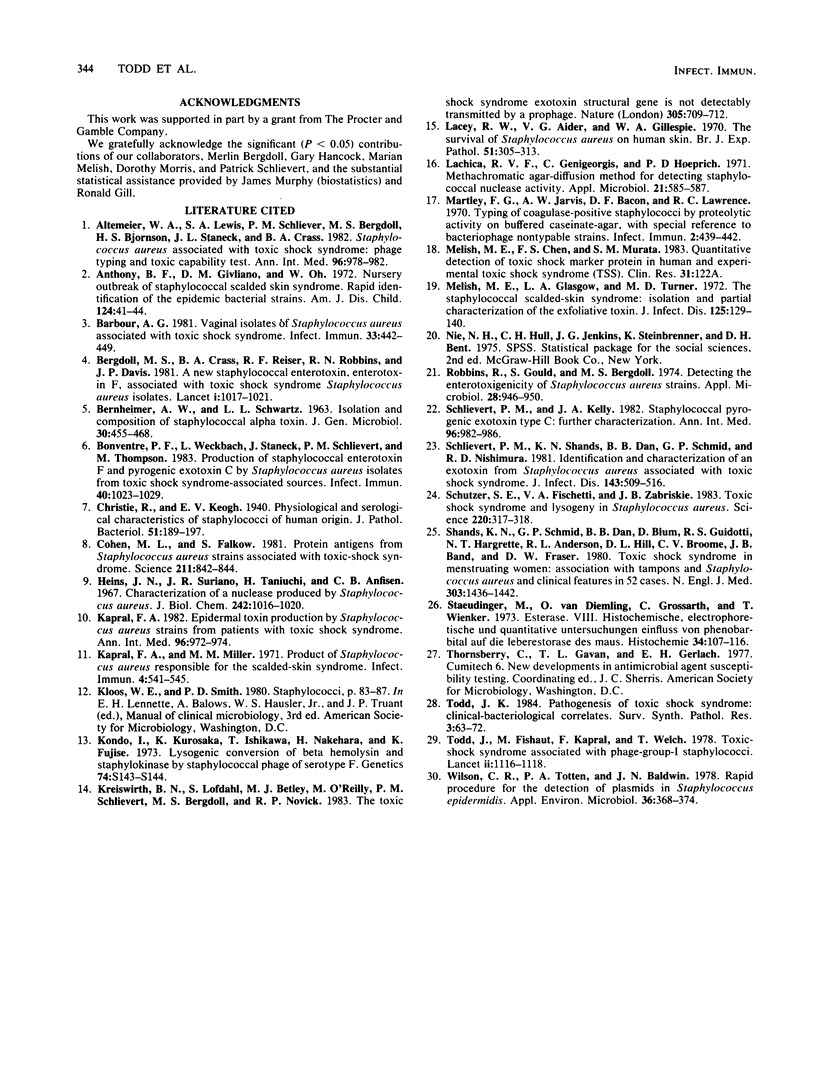
Images in this article
Selected References
These references are in PubMed. This may not be the complete list of references from this article.
- Altemeier W. A., Lewis S. A., Schlievert P. M., Bergdoll M. S., Bjornson H. S., Staneck J. L., Crass B. A. Staphylococcus aureus associated with toxic shock syndrome: phage typing and toxin capability testing. Ann Intern Med. 1982 Jun;96(6 Pt 2):978–982. doi: 10.7326/0003-4819-96-6-978. [DOI] [PubMed] [Google Scholar]
- Anthony B. F., Giuliano D. M., Oh W. Nursery outbreak of staphylococcal scalded skin syndrome. Rapid identification of the epidemic bacterial strain. Am J Dis Child. 1972 Jul;124(1):41–44. doi: 10.1001/archpedi.1972.02110130043006. [DOI] [PubMed] [Google Scholar]
- BERNHEIMER A. W., SCHWARTZ L. L. Isolation and composition of staphylococcal alpha toxin. J Gen Microbiol. 1963 Mar;30:455–468. doi: 10.1099/00221287-30-3-455. [DOI] [PubMed] [Google Scholar]
- Barbour A. G. Vaginal isolates of Staphylococcus aureus associated with toxic shock syndrome. Infect Immun. 1981 Aug;33(2):442–449. doi: 10.1128/iai.33.2.442-449.1981. [DOI] [PMC free article] [PubMed] [Google Scholar]
- Bergdoll M. S., Crass B. A., Reiser R. F., Robbins R. N., Davis J. P. A new staphylococcal enterotoxin, enterotoxin F, associated with toxic-shock-syndrome Staphylococcus aureus isolates. Lancet. 1981 May 9;1(8228):1017–1021. doi: 10.1016/s0140-6736(81)92186-3. [DOI] [PubMed] [Google Scholar]
- Bonventre P. F., Weckbach L., Staneck J., Schlievert P. M., Thompson M. Production of staphylococcal enterotoxin F and pyrogenic exotoxin C by Staphylococcus aureus isolates from toxic shock syndrome-associated sources. Infect Immun. 1983 Jun;40(3):1023–1029. doi: 10.1128/iai.40.3.1023-1029.1983. [DOI] [PMC free article] [PubMed] [Google Scholar]
- Cohen M. L., Falkow S. Protein antigens from Staphylococcus aureus strains associated with toxic-shock syndrome. Science. 1981 Feb 20;211(4484):842–844. doi: 10.1126/science.7466361. [DOI] [PubMed] [Google Scholar]
- Heins J. N., Suriano J. R., Taniuchi H., Anfinsen C. B. Characterization of a nuclease produced by Staphylococcus aureus. J Biol Chem. 1967 Mar 10;242(5):1016–1020. [PubMed] [Google Scholar]
- Kapral F. A. Epidermal toxin production by Staphylococcus aureus strains from patients with toxic shock syndrome. Ann Intern Med. 1982 Jun;96(6 Pt 2):972–974. doi: 10.7326/0003-4819-96-6-972. [DOI] [PubMed] [Google Scholar]
- Kapral F. A., Miller M. M. Product of Staphylococcus aureus responsible for the scalded-skin syndrome. Infect Immun. 1971 Nov;4(5):541–545. doi: 10.1128/iai.4.5.541-545.1971. [DOI] [PMC free article] [PubMed] [Google Scholar]
- Kreiswirth B. N., Löfdahl S., Betley M. J., O'Reilly M., Schlievert P. M., Bergdoll M. S., Novick R. P. The toxic shock syndrome exotoxin structural gene is not detectably transmitted by a prophage. Nature. 1983 Oct 20;305(5936):709–712. doi: 10.1038/305709a0. [DOI] [PubMed] [Google Scholar]
- Lacey R. W., Alder V. G., Gillespie W. A. The surivival of Staphylococcus aureus on human skin. An investigation using mixed cultures. Br J Exp Pathol. 1970 Jun;51(3):305–313. [PMC free article] [PubMed] [Google Scholar]
- Lachica R. V., Genigeorgis C., Hoeprich P. D. Metachromatic agar-diffusion methods for detecting staphylococcal nuclease activity. Appl Microbiol. 1971 Apr;21(4):585–587. doi: 10.1128/am.21.4.585-587.1971. [DOI] [PMC free article] [PubMed] [Google Scholar]
- Martley F. G., Jarvis A. W., Bacon D. F., Lawrence R. C. Typing of coagulase-positive staphylococci by proteolytic activity on buffered caseinate-agar, with special reference to bacteriophage nontypable strains. Infect Immun. 1970 Oct;2(4):439–442. doi: 10.1128/iai.2.4.439-442.1970. [DOI] [PMC free article] [PubMed] [Google Scholar]
- Melish M. E., Glasgow L. A., Turner M. D. The staphylococcal scalded-skin syndrome: isolation and partial characterization of the exfoliative toxin. J Infect Dis. 1972 Feb;125(2):129–140. doi: 10.1093/infdis/125.2.129. [DOI] [PubMed] [Google Scholar]
- Robbins R., Gould S., Bergdoll M. Detecting the enterotoxigenicity of Staphylococcus aureus strains. Appl Microbiol. 1974 Dec;28(6):946–950. doi: 10.1128/am.28.6.946-950.1974. [DOI] [PMC free article] [PubMed] [Google Scholar]
- Schlievert P. M., Kelly J. A. Staphylococcal pyrogenic exotoxin type C: further characterization. Ann Intern Med. 1982 Jun;96(6 Pt 2):982–986. doi: 10.7326/0003-4819-96-6-982. [DOI] [PubMed] [Google Scholar]
- Schlievert P. M., Shands K. N., Dan B. B., Schmid G. P., Nishimura R. D. Identification and characterization of an exotoxin from Staphylococcus aureus associated with toxic-shock syndrome. J Infect Dis. 1981 Apr;143(4):509–516. doi: 10.1093/infdis/143.4.509. [DOI] [PubMed] [Google Scholar]
- Schutzer S. E., Fischetti V. A., Zabriskie J. B. Toxic shock syndrome and lysogeny in Staphylococcus aureus. Science. 1983 Apr 15;220(4594):316–318. doi: 10.1126/science.6220467. [DOI] [PubMed] [Google Scholar]
- Shands K. N., Schmid G. P., Dan B. B., Blum D., Guidotti R. J., Hargrett N. T., Anderson R. L., Hill D. L., Broome C. V., Band J. D. Toxic-shock syndrome in menstruating women: association with tampon use and Staphylococcus aureus and clinical features in 52 cases. N Engl J Med. 1980 Dec 18;303(25):1436–1442. doi: 10.1056/NEJM198012183032502. [DOI] [PubMed] [Google Scholar]
- Staeudinger M., von Deimling O., Grossarth C., Wienker T. Esterase. 8. Histochemische, elektrophoretische und quantitative Untersuchungen zum Einfluss von Phenobarbital auf die Leberesterase der Maus. Histochemie. 1973 Feb 6;34(2):107–116. doi: 10.1007/BF00303983. [DOI] [PubMed] [Google Scholar]
- Todd J. K. Pathogenesis of toxic shock syndrome: clinical-bacteriological correlates. Surv Synth Pathol Res. 1984;3(1):63–72. [PubMed] [Google Scholar]
- Todd J., Fishaut M., Kapral F., Welch T. Toxic-shock syndrome associated with phage-group-I Staphylococci. Lancet. 1978 Nov 25;2(8100):1116–1118. doi: 10.1016/s0140-6736(78)92274-2. [DOI] [PubMed] [Google Scholar]
- Wilson C. R., Totten P. A., Baldwin J. N. Rapid procedure for the detection of plasmids in Staphylococcus epidermidis. Appl Environ Microbiol. 1978 Aug;36(2):368–374. doi: 10.1128/aem.36.2.368-374.1978. [DOI] [PMC free article] [PubMed] [Google Scholar]



